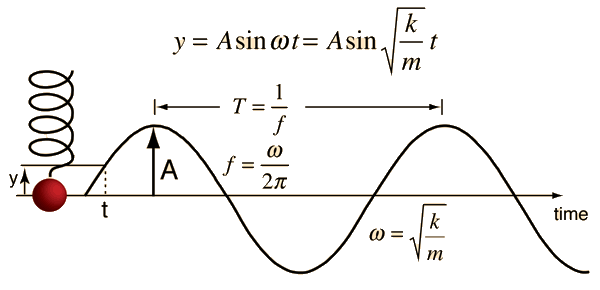

Downstairs, you need the momentum of inertia for a point mass m at a distance l from the point of rotation, which is ml 2.

In the case of mass and this pendulum, it depends on how long the pendulum is, how big the mass is, but you can work it out and extract κ. It’s not a universal number that’s known to everybody like the spring constant of anything. Then the ω here will be–this κ is a generic κ that goes into whatever it is for that problem. Then, you stared at the formula and say hey, this guy must be the κ I’m looking for because that number times θ is the restoring torque. You did this piece of thinking, and namely, you disturbed the system from equilibrium and found the restoring torque. If you do, then the force is like this, the separation vector r from the pivot point is this, and r cross F will be non-zero because the angle between them is not 0, and you remember that torque is equal to rF sin θ, and I told you for small angles, this can be rF θ, and r happens to be, in this problem, the length of the pendulum, so it’s really - mgl θ. Now, you come along and you disturb that by turning it by an angle θ. If you leave it like this, it would stay this way forever. The pendulum is hanging, say a massless rod, with some mass m at the bottom. Let us take the easiest problem of a pendulum. But in rotation problems, the typical situation is the following. In the case of a spring, they would have to give you k or they may tell you indirectly if I pull this spring by 9 inches, I exert a certain force, they’re giving you F and they’re giving you x and you can find k. Sometimes, they may not tell you what κ is. You can find θ, you can derivatives and so on. You just stick it in and mindlessly calculate all the formulas. Now, if someone tells you this is κ, then you are done. You can call it A cos (ωt- φ, and ω now will be the ratio of this κ at the moment of inertia, because mathematically that’s the role played by κ and I. Mathematically, that equation’s identical to that, and θ then will look like some constant. If you find this κ then you can say -κ times θ is I times d 2θ over dt 2. If you make θ negative it’ll try to bring you back. That means if you make θ positive, the torque will try to twist you the other way. It’ll still be proportional to θ, and you put a minus sign for the same reason you put a minus sign here to tell you it’s a restoring torque. If θ is not 0, it’ll begin as some function of θ, but the leading term would be just θ. What can be the expression for the restoring torque? When you don’t do anything, it doesn’t do anything, so it’s a function of θ that vanishes when θ is 0. So, now we don’t have a restoring force but we have a restoring torque. But if you come and twist it by angle θ, give it a little twist, then it will try to untwist itself.

Now, we don’t have a mass but we have a bar, let’s say, suspended by a cable, hanging from the ceiling, and it’s happy the way it is. But it is a very generic situation, so I’ll give you a second example.

This is an example of simple harmonic motion. That means when the time is 0, x will have the biggest value A. That tells you what your clock is doing when x is a maximum, and we can always choose φ to be 0. A is the amplitude, φ is called the phase. The most general answer looks like A cos ωt - φ. And what’s the solution to this equation? I think we did a lot of talking and said look, we are looking for a function which, when differentiated twice, looks like the same function up to some constants, and we know they are trigonometry functions. But if you pull it so the mass comes here, you move it from x = 0 to a new location x then, there is a restoring force F, which is - kx, and that force will be equal to mass times acceleration by Newton’s law, and so you’re trying to solve the equation d 2x/dt 2 = -k/m times x, and we use the symbol, ω 2 = k/m, or ω square root of k/ m. This spring has a certain natural length, which I’m showing you here. The standard textbook example is this mass on spring. Professor Ramamurti Shankar: Stable equilibrium, and if you disturb them, they rock back and forth and there are two simple examples. Example Equations of Oscillating Objects Fundamentals of Physics I PHYS 200 - Lecture 17 - Simple Harmonic MotionĬhapter 1.


 0 kommentar(er)
0 kommentar(er)
